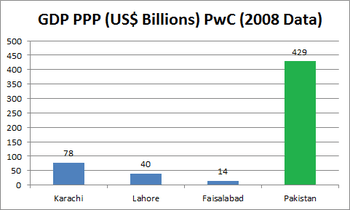List of Pakistani provinces by gross domestic product
This is a list of provinces of Pakistan by their gross state product (GSP) (the value of the total economy, and goods and services produced in the respective province) in nominal terms. GSP is the provincial-level counterpart of the national gross domestic product (GDP), the most comprehensive measure of a country's economic activity.
Dynamics
Pakistan, as of 2019, had a gross domestic product (GDP) of $284.214 billion US$. This value can be further divided into the provincial levels (GSP), providing an outlook of how much value each province contributes to the national GDP. Pakistan has traditionally followed a "top-down" approach in its analysis of economic development; that is, authorities have scarcely attempted to break up national GDP statistics into provincial and subnational units and have focused more on the federation as a whole. Thus, many accounts of provincial GDPs that do exist have usually been projected estimates made by economists, based on the likely percentage of contribution of the respective province to the national GDP and some yearly studies.
As of 2010, Punjab had the largest economy in Pakistan (contributing 57% to Pakistan's GDP), followed by Sindh (27.5%), Khyber Pakhtunkhwa (8%) and Balochistan (3%). Islamabad, the capital entity, contributes 1%; while FATA contribute 1.5%.[1]
Punjab, which is the largest province in terms of population, dominates other provinces in contributing to the national economy. As of 2017, Punjab had a GDP of $173 billion[2] which has steadily continued to grow. It is featured well within the list of country subdivisions with a GDP over $100 billion. Sindh's GDP with 83 billion is to a large extent influenced by the economy of Karachi, its capital and Pakistan's largest city.
As per 2018, Provincial share in total Tax Collection in Pakistan are Punjab 48%, Sindh 27%, Khyber Pakhtunkhwa 17%, Balochistan 8%.
Provinces by GDP (nominal)
Figures are derived from statistics in 2019
| Province or territory | GDP (Billions USD out of US$284.214bn) |
|---|---|
| 163.42 | |
| 76.74 | |
| 27.00 | |
| 8.53 | |
| 4.60 | |
| 2.84 | |
| 7 | |
| Total (Pakistan) | 314 |
| 314 |
|---|
GNI per capita in thousands of US$ (2011 PPP) in Pakistan by administrative unit
| Unit[3] | 1990 | 1995 | 2000 | 2005 | 2010 | 2015 | 2018 |
|---|---|---|---|---|---|---|---|
| Azad Jammu & Kashmir | 4,462 | 4,704 |
4,699 |
5,546 |
5,471 |
5,544 |
5,834 |
| Balochistan | 2,475 | 2,599 |
2,597 |
3,030 |
2,896 |
3,555 |
4,628 |
| FATA | 1,969 | 2,065 |
2,064 |
2,396 |
2,367 |
2,396 |
2,509 |
| Gilgit-Baltistan | 3,076 | 3,235 |
3,232 |
3,787 |
3,738 |
4,961 |
6,849 |
| Islamabad (ICT) | 7,503 | 7,935 |
7,927 |
9,452 |
9,322 |
8,744 |
8,527 |
| Khyber Pakhtunkhwa | 2,705 | 2,843 |
2,840 |
3,319 |
3,490 |
3,897 |
4,328 |
| Punjab | 2,898 | 3,047 |
3,044 |
3,562 |
4,289 |
5,094 |
5,503 |
| Sindh | 3,119 | 3,280 |
3,277 |
3,840 |
4,041 |
4,269 |
4,483 |
| Pakistan | 3,195 | 3,361 |
3,358 |
3,938 |
4,227 |
4,727 |
5,190 |
Top cities by GDP (Nominal)

The table below lists the top cities by their Nominal GDP in 2012, based on a study by the McKinsey Global Institute[4]
| Rank | City | Province | 2012 Nominal GDP (in USD) |
2012 Per Capita Nominal Income (in USD) |
|---|---|---|---|---|
| 1 | Karachi | Sindh | $ 64 billion | $ 6000 |
| 2 | Lahore | Punjab | $ 35 billion | $ 5000 |
| 3 | faisalabad | Punjab | $ 20.5 billion | $ 5000 |
| 4 | sialkot | Punjab | $ 13 billion | $ n/a |
| 5 | gujranwala | Punjab | $ 12 billion | $ n/a |
| 6 | Multan | Punjab | $ 6.5 billion | $ n/a |
| 7 | peshawar | Khyber Pakhtunkhwa | $ 6 billion | $ n/a |
| 8 | quetta | balochistan | $ 4 billion | $ n/a |
| 9 | Rawalpindi | punjab | $ 3.96 billion | $ n/a |
| 10 | islamabad | Islamabad Capital Territory | $ 3.14 billion | $ n/ak |
Top cities by GDP (PPP)

The table below lists the top cities by their GDP (PPP).
| Rank | City | Province | GDP (PPP) |
|---|---|---|---|
| 1 | Karachi | Sindh | $114 Billion (2014)[6] |
| 2 | Lahore | Punjab | $58.14 Billion (2015)[7][8] |
| 3 | Sialkot | Punjab | $49 Billion (2013)[9] |
References
- "Economics and Extremism". Dawn News. Shahid Javed Barki. Retrieved 10 July 2017.
- "'Punjab's GDP higher than that of many countries'". Express Tribune. Retrieved 16 July 2017.
- "GNI per capita in thousands of US$ (2011 PPP) - Global Data Lab". globaldatalab.org. Retrieved 17 March 2020.
- "Urban world: Cities and the rise of the consuming class". Retrieved 2017. Check date values in:
|accessdate=(help) - Emerging market city economies set to rise rapidly in global GDP rankings says PricewaterhouseCoopers LLP Archived 2013-05-31 at the Wayback Machine
- Centre for Risk Studies at the University of Cambridge Judge Business School. "Karachi factsheet: Lloyd's City Risk Index". Lloyd's City Risk Index 2015–2025. Lloyd's. Archived from the original on 24 November 2016. Retrieved 23 November 2016.
- "Lahore Fact Sheet". Lloyd's. Archived from the original on 21 August 2016. Retrieved 19 August 2016.
- "GaWC – The World According to GaWC 2016". lboro.ac.uk. 24 April 2017. Retrieved 30 April 2017.
- "Punjab At A Glance". Punjab Board of Investment & Trade, Government of The Punjab. 2016. Archived from the original on 16 April 2017. Retrieved 15 April 2017.